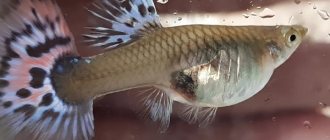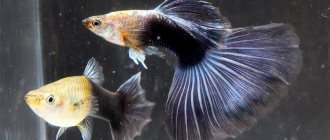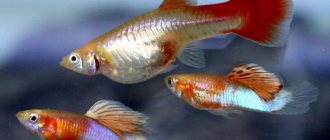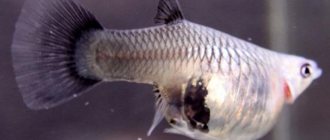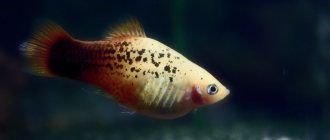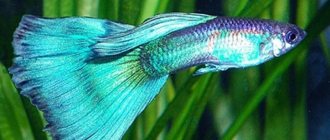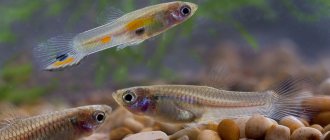Guppy, one of the most popular aquarium fish, does not produce eggs, but live fry. From the first days, guppy fry are able to swim and feed independently. Once born in a community aquarium, the fry rarely survive. Defenseless babies easily become prey for adult fish, which is why aquarists prefer to breed guppies in special aquariums. How to organize the right conditions for the offspring, what to feed and when to transplant into a large tank - there are many questions. Let's talk in more detail about the nuances of keeping and caring for tiny jellyfish.
Birth of fry
A pregnant female guppy looks different from other fish. Her belly is greatly enlarged and the dark spot near the anal fin is enlarged. The behavior of the fish also suggests that it will soon give birth: it becomes restless, tries to retire, hide in the thickets of plants. Having noticed such features, the aquarist must take measures to preserve future offspring. First of all, you need to move the female to a separate aquarium. This should be done in advance so that the guppy adapts to new conditions. At the same time, premature birth must not be allowed, otherwise the premature fry will die.
Attention! If the right moment for hatching is missed, allow the fish to breed in a community aquarium. After birth, the fry must be carefully caught with a plastic glass and released into a prepared tank.
At the moment of birth, the guppy freezes, its body trembles. One after another, the fry appear within an hour. Some float to the surface and then sink. Weakened children cannot break the shell, so they sink to the bottom and lie there, gaining strength. The process needs to be monitored in order to have time to remove the female after birth. Otherwise, newborns will become food for their own mother.
Water changes.
In an aquarium with fry, the water needs to be changed very often. I make a little change every day. That's why I use small aquariums. I just take a white mug (the fry are clearly visible in it if they come across them) and scoop them up. I top it up with it. The main thing is to maintain the same temperature. The procedure takes 2 minutes. If I drain a larger volume, I use an air hose with a piece of gas fabric at the end. In larger aquariums, I still put the same piece of foam rubber on the end of the hose.
Creation of necessary conditions of detention
Guppies are considered unpretentious fish, but juveniles require special care. In order for the fry to develop quickly, grow healthy and active, all conditions must be created for them:
- The size of the aquarium for guppy fry should correspond to the number of individuals. The more newborns, the more capacious the vessel. It is preferable for the fish to be kept in a fish tank attached to a common tank.
- Lighting in the first 3-5 days should be around the clock. Then you can gradually reduce the duration of daylight to 16 hours a day.
- The optimal water temperature for fry is +28ºC. During the cold season, a water heater may be required.
- Clean, oxygenated water is an indispensable condition for the health and growth of fish. To maintain the aquatic environment in the aquarium, install the necessary equipment: a filter, an aerator, and also regularly clean the bottom. The filter should be covered with fabric to prevent the fry from being drawn inside.
Proper organization of care for guppy fry involves a diet. If you feed babies whatever you have to and do not observe the frequency of food distribution, they may die.
Basic conditions for fry
Fry, like any babies, are very sensitive and demanding of their living conditions, so preparation must be taken seriously.
Aquarium volume
You need to select housing for baby fish based on the breed, size and growth rate of the babies. If development occurs at a rapid pace and the fish are large, it is better to take a 40-liter container. If the fry are of smaller breeds, a 20-30-liter aquarium will be enough.
Water requirements
The fry must be kept in an environment protected from bacteria and toxins, so it is important to prepare not only the water, but also the aquarium. The walls of the tank must be washed with salt or soda to disinfect. The water must be clean and as close in composition to natural water as possible, and must be settled. To maintain the sterility of the liquid at the proper level, you need to replace at least 10% of the water in the container with clean water every day.
Unlike their adult relatives, fry, as a rule, are not too sensitive to temperature changes, so it would be wise to stick to the average optimal temperature for aquarium fish, which is +24-26 degrees. At the same time, try to keep the aquarium away from heating devices, as overheating can lead to the death of the offspring.
Did you know? Swordtail fry do not have sex chromosomes and, depending on the conditions of detention, can become males or females. It is noteworthy that in good conditions more males develop.
Soil and plants
The aquarium for breeding must be extremely clean and convenient for daily cleaning, so the soil in it will be superfluous, because waste products and food particles must be removed as they appear, so that the babies do not get poisoned, and residues settled in the soil can cause water contamination .
Familiarize yourself with the features of choosing the best soil for an aquarium, and also learn how to care for plants such as hornwort, cryptocoryne, Hemianthus Cuba, Java moss, Pogostemon erectus, Pogostemon Helfera, Pogostemon octopus, Echinodorus.
There should not be too many plants; they should be placed taking into account the fact that they will require daily washing.
Will additional equipment be needed?
In addition to a thermometer that will allow you to monitor the water temperature in a children's aquarium, you may need a medium-power filter to properly purify the water. You cannot install a device that is too powerful, because the fry will be drawn into the filter. It also wouldn’t hurt to install an aerator that will saturate the water with oxygen.
Aerator for aquarium
How and what to feed guppy fry
The newly born fish has a microscopic mouth opening. Gupikas do not know how to bite off or chop food; they capture the food entirely. This means that the fry can eat only the smallest food, ground into dust. Those who care for guppy fry must monitor the frequency of feeding and the quality of food components. If your fish eat too often and too much, it is detrimental to their health.
Feeding frequency
The first 5-7 days are decisive: if the fish survive this week, most likely they will grow further without problems. During the most important period, it is necessary to calculate the norms and feeding schedule for guppy fry:
- every 4 hours – in the first week;
- 4 times a day – until the end of the second decade;
- Then they switch to three feedings a day.
“Living dust” – this is where the fry begin to feed. This is the ideal food, suitable in size and energy composition.
Natural feed
The fry grow best by consuming live food. Protein promotes active growth. Mobile larvae, worms, and protozoa awaken the hunter's instinct in guips. Ciliates - “live dust” measuring 0.15-0.25 mm is suitable for the smallest fish.
“Living dust” - ciliate slipper
You can grow food for the fry yourself at home: pour some of the water from the aquarium into a jar and place it on the windowsill. In a few days, phytoplankton - tiny algae - will appear. This food is drawn into a syringe and released into the vessel where the newborn guppies are kept.
A little later, you can feed the fry with Artemia larva, naupliia. This is a high-calorie food, it often causes obesity in fish and is used as a delicacy. However, there is a replacement for it - a microworm, a nematode. At the age of one month and older, the fry can feed on bloodworms, tubifex and other larvae. In addition, you can safely give dry food to older fish by rubbing it between your fingers.
Commercial feed
Growing live food is quite difficult and not very pleasant. Therefore, you can always buy ready-made fish food. Among the branded foods for guppy fry, several brands stand out:
- Sera micropan, micron is a powder that forms a film on the water surface. The fish rise to the surface of the water and feed themselves as needed.
- Tetra mikromin is a powder food formulated to suit the needs of guppy fry. Contains vitamins and microelements. Disinfected with ultraviolet light.
- Tetra biomin is a paste that is easy to use. You just need to dip the tube in water and squeeze out the appropriate portion.
- JBL is a specialized food intended for viviparous fish. Its composition is dominated by easily digestible proteins.
Live food substitutes
Since live food is best absorbed by the digestive system, it cannot be replaced with anything. But in the absence of larvae, worms, and insects, there is a temporary alternative: food from the human table. The fry can be fed with homemade food:
- Chicken egg yolk. Peel the hard-boiled egg, grind the yolk, dilute with aquarium water. Place the mixture in cheesecloth, roll it into a knot and squeeze it into the aquarium. This type of food quickly deteriorates and pollutes water.
- Curdled milk. It decomposes more slowly, and fish eat it more readily. Pour boiling water over the curdled milk; the casein will curdle like cottage cheese. Place the curd in a sieve and rinse off the whey. Place the lump in the aquarium, wrapped in gauze.
- Powdered milk. A real delicacy that the fry gobble up with incredible speed. The product has high nutritional value, but it should not be given to fish often.
It is unacceptable to completely replace live food with such products. Guppies must eat specialized food, and fry in particular, otherwise they will get sick.
What should be the frequency of feeding the fry?
The fry need to be fed frequently, up to 5-6 times a day, but this is just a recommendation that the Internet is full of. I’ll tell you from my own experience, feeding red neon fry with ciliates. Feeding was done 2 times a day, in large portions, before leaving for work and after returning from work. The death of the fry was not observed at all; the ciliate constantly swam in the fry, only its numbers changed over time, since it was actively eaten by the fry.
If you feed the fry with dry food, then the recommendation to add food 5 times a day should be followed; it is given in small portions, since it quickly, within a couple of hours, spoils the water, especially high-protein food and its excess must be carefully removed after each feeding and the dosage adjusted. Yes, snails, which must be present in the hatchery, can help with cleaning, but they cannot always cope and if you miss this moment, you will lose all the fry.
How long do baby guppies grow?
The growth rate of fry depends on several factors:
- aquarium volume;
- temperature and water quality;
- lighting;
- diet.
In the first week, the fry grows to approximately 7 mm; by two weeks it increases in height to 20 mm. Females grow to 4-6 cm at the time of puberty - this is about 4-5 months. Males are significantly inferior in height - body length is only 3-4 cm.
Attention! You can accelerate the growth of fry by heating the water to 26-27 ºC, changing it daily by 30-50%, and also leaving the backlight on. A prerequisite for rapid growth is four meals a day.
The main causes of death of fry in an aquarium and methods for eliminating them
Of course, when breeding aquarium fish, loss of offspring is not excluded. This may be due not only to the inexperience of the owner, but also to a number of other reasons:
We looked at the main stages of breeding aquarium fish fry and the features of caring for them. This is an important and responsible process that requires attention and time, but if simple rules are followed, it will not bring excessive trouble to the owner and very soon the new grown-up individuals will delight the eye in the common aquarium.
Source
How to determine the sex of guppy fry
Experienced aquarists know that fry need to be sorted as they grow older. Females and males need to be placed in different aquariums to prevent early pregnancy. Determining the sex of guppy fry is not as difficult as it seems: differences are noticeable within half a month after birth. The first signs are identified on the female’s abdomen in the form of black spots. However, some varieties of guppies do not have such differences.
You can distinguish a female from a male by the absence of a pointed anal fin. In males, this organ is formed by three months, while in females the fin remains unchanged. Females do not look as bright as males, and they also do not have pronounced bushy tails.
Keeping fish of different sexes separately is better for their health. Guppies develop calmly and do not waste energy on mating games.
Preparing conditions for a pregnant female
Pregnancy lasts 25–35 days.
Manifests itself in an increase in the size of the abdomen. 2–3 days before birth, the abdomen “squares up” and a dark spot appears behind.
At the final stage of pregnancy, the water is not changed. The temperature is maintained constant.
The optimal water temperature in the aquarium is 24–26 °C.
24–30 hours before giving birth, the female becomes little active, does not eat, and stays near water heating devices.
If separate keeping of juveniles is planned, then the fertilized female is placed in a prepared container with clean, transparent water and plants.
Launch into a community aquarium
When can you safely add fry to adult fish? The answer is simple: as soon as they grow enough to avoid being eaten. Age doesn't really matter. Some individuals can be quite large after two weeks, while others remain tiny at this time. A general rule for all fish, not just guppies: when the fry have grown to 1.5 cm, they are ready for transplanting.
Before global relocation, you need to make sure that the raised babies will survive in a common aquarium. To do this, the tank must have a lot of shelters: plants among which the guips can hide. From among the inhabitants of the aquarium, it is necessary to exclude aggressive and predatory fish, for which small guppies will become tasty prey.
On a note! The fry should be prepared for transplantation gradually: lower the water temperature, bringing the parameters of the fish tank closer to those of the general tank.
Cleaning and siphoning.
Do not move fry to a larger aquarium. It will be difficult to feed them, they will not see the food, cleaning and replacing in large quantities is also much more difficult. At first, I use plastic containers or five-liter plastic drinking water bottles. At the beginning of life, fry are fed very often (how and what, read here), therefore they often have to be cleaned of food residues. The best solution, still the same, is a vacuum cleaner from aliexpress. But when he was not there, I used these devices of my own invention.
First, take a large disposable syringe from the pharmacy and use a plastic cocktail straw instead of a needle. If it doesn't hold tightly, use aquarium silicone or hot plastic glue. Point it at the dirt and suck it out.
How to care if you were born in a community aquarium
Often, a fish’s pregnancy goes unnoticed, and guppy fry are born in a community aquarium. At the same time, the risk of death of the fry is enormous: those who did not manage to hide in the thickets of plants become food for adult fish. If an aquarist is not interested in breeding guppies, he may not take any measures to protect the babies.
In case of uncontrolled delivery, there is a chance that the guppies will be saved in the first days, but they will need help:
- planting plants floating on the surface and in the water column;
- smooth heating of water in the aquarium up to +26ºC;
- changing 30-40% of water twice a week;
- enhanced aeration, filtration;
- pouring crushed food into the thickness of the plants.
Fish that have grown from the first days among the older generation have an advantage: they are much stronger and in better health.
Malki - who is this?
Contents
hide
1 Malki - who is this?
2 Cleaning and siphon.
3 Water changes. 3.1 If you have other inventions and developments, share them in the comments, I will be very glad to communicate!
4 How to transfer eggs and care for them, read in these posts: 4.1 Breeding and raising fry: a description of personal experience with photographs and videos! - Read!
4.2 Aquarium zebrafish - how to get eggs and raise fry without much difficulty! - Read! 4.2.1 Recent Posts
A joyful event happens in the life of almost every aquarium lover. Or, one morning he discovers eggs laid on a leaf or stone. Or already independently swimming fry. Be it fry of viviparous fish such as guppies, molynesias and swordtails. Or fry of various species of cichlids, carefully protected by their parents and often hiding in the female’s mouth.
Who is this little guy? As Ushakov’s explanatory dictionary tells us, a fry is a small fish larva that has just hatched from an egg.
And now, when the first wave of admiration from what you saw in your aquarium has passed, you usually have a desire to preserve and try to raise future fish. But you must understand that due to micro size and vulnerability, almost all the laws of aquarium management for a large aquarium stop working. Be it feeding, filtering, catching and replanting, water changes and so on.
Due to the threat of being eaten, fry of almost all types of aquarium fish are kept separately. And if transferring eggs is not difficult (read this link for how to transfer eggs correctly), then with fry it is a little more difficult. No nets will help here. If these are fry of viviparous fish, then they usually stay near the surface and can be scooped up with an ordinary white mug. If there are other types, then I usually use a vacuum gravel cleaner (as in the photo), which can be bought for 2 euros on Aliexpress using this link. It is ideal not only for removing waste, but also for sucking and transferring fry.
How long does it take to grow
The growth of guppy fry will depend on light intensity, water temperature and feeding. The optimal temperature conditions were described above, and round-the-clock lighting should be added to them in the first few days of life. If the temperature is lowered a little, the fish will grow more slowly, but will become larger. As temperatures rise, growth accelerates, but adult guppies will be smaller than their relatives raised in other conditions. From the photo you can choose what size you want the individual to be and adjust the temperature. However, this can affect the health and lifespan of the fish.
